An elegant French-Japanese summer menu beckons from this vintage enclave at Fort Canning.
Each season, Executive Chef Keisuke Matsumoto of Lewin Terrace returns from his travels around the world, lugging suitcases full of equipment, cutlery, tableware and, of course, unique ingredients that can only be procured overseas. This time, he whips up a seasonal set marking the beginning of summer in Japan with the six-course Summer Sho-Mi menu.
It is difficult to express in words the experience of the Japanese-French fusion meal; instead, try to think of it as a Studio Ghibli film. Like the legendary film studio, Chef Matsumoto aims to bring you through lush scenery that is rich in different elements, but all working together as such a cohesive unit that it’s hard to pinpoint a favourite. Each dish flows from one to the next and into the other, a new experience that just gets better and better as more elements are added.
This particular journey was one made up of intriguing elements, delightful dishes and extremely fresh ingredients. While all contributed to the experience, some in particular, stood out.
After homemade bread paired with a refreshing yuzu butter, the waiters served up the Omotenashi, a sort of amuse bouche. Beancurd skin crisp topped with mascarpone cheese and minced beef accompanied by dehydrated tomato shells made for a refreshing bite.
Then they brought the Hassan out, also known as the starter. We were shown two different dishes, the awabi (Hokkaido abalone) or foie gras brulee. Both cold dishes were served in delicate tableware that Chef had personally brought back from his trip. The awabi sat in a glass of dashi (a stock of konbu and bonito flakes) jelly and was topped with a sliver of edible gold. The creamy foie gras was hidden by a cold sweet corn cream with a sprinkle of soba seeds.
“How could it get any better?” murmured one of the members of the media as she savoured the umami taste of the cold jelly that followed quickly by a burst of sweetness from the abalone. The rest of us nodded in agreement and fell into silence as we savored the gentle texture of the dish that whetted our appetite for the upcoming dishes. The sweet brulee was more dessert than starter, the corn a creamy bite that ended too quickly.
The next dish, the Wagyu Shabu-Shabu, comprised slivers of delicately pink and raw wagyu atop gnocchi. It seemed small and unimpressive… until the coffee siphons appeared. The gimmicky wonder of the siphons sent the room into a tizzy; the chemistry-set contraption had two compartments, the top filled with celery and other fresh vegetables, the bottom, a clear dashi stock. With a flourish the waiters set the tea light below aflame, and as the dashi stock heated and began to boil, it rose through a tube in the siphon and bubbled through, simmering the vegetables before cooling and sinking back into it’s rightful place, this time, with the goodness of the vegetables. This was then poured over the wagyu and gnocchi. Tinged with wasabi, the gnocchi—light instead of starchy—was an enjoyable companion to the sweetened dashi and tender slices of beef.
To calm us down from the excitement, something comforting and more familiar was introduced. The fish course, Sole Meuniere, was served, shortly followed by the Nippon Rossini—wagyu steak served with foie gras terrine, mushroom paste, black wild rice and truffle. These dishes were more familiar to the tastebuds, but they were still an intriguing sight and taste to behold.
Just before the dessert, the Amane Melon Soup was brought out, comprising a tray covered in billowing dry ice smoke around shot glasses. It might have looked simple, but the chilled soup inside was made from one of Japan’s finest melons, which are sold for several hundred dollars in markets around the world. The fruity aroma that wafts up before you tip the shot glass into your mouth builds anticipation, the slight yuzu infusion salted just to bring surprise to the game.
As the meal winds down, the wine finished, the Riz Au Lait is brought out, with its leopard-print chocolate sauce sitting within a shell of chocolate that hides spiced rice pudding and a quenelle of caramel ice cream.
A meal at Lewin Terrace is no ordinary meal, it is an experience. From climbing up several flights of stairs up Fort Canning Hill, meandering through to the pre-war colonial building, up till the very end of the six-course meal, you find that Lewin Terrace is an encounter to be savored.
Lewin Terrace’s Summer Sho-Mi is available for lunch (11.30am to 2.30pm) and dinner (6.30pm to 11pm), priced at $118++ per person ($180++ with wine pairing); and the luxurious Wakon Yosai menu is available for dinner only, priced $178++ ($240++ with wine pairing).
Lewin Terrace
21 Lewin Terrace
Singapore 179290
+65 6333 9905


